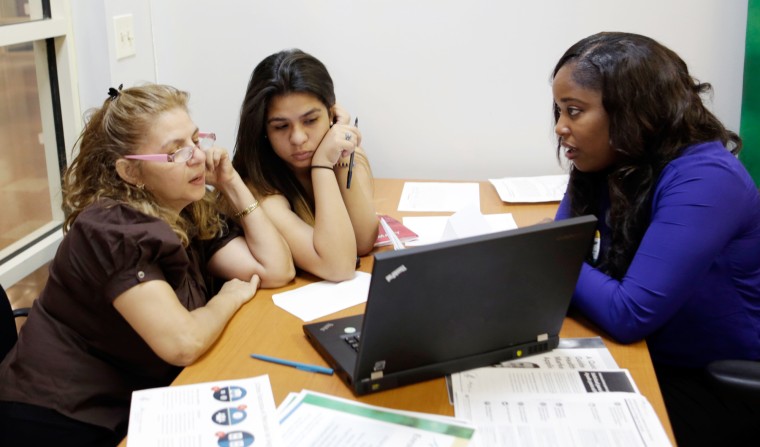
Government officials confirmed on Monday that more than 2 million people have signed up for private health insurance on the new government websites, but just under a quarter of them are the presumably healthy young adults needed to make the plans profitable.
The official report on December signups confirms the 2.2 million number leaked by a White House official on Dec. 31. The “scrubbed” numbers released by the Health and Human Services Department also paint a picture of just who’s signing up — and it’s overwhelmingly middle-aged people looking for government subsidies.
That's not necessarily bad, experts say. What really matters is that there's a good mix of healthy to sick people signing up, and details like that are not yet available.
A breakdown of who’s signed up so far on Healthcare.gov and various state-run websites shows 79 percent of enrollees will get a government subsidy — in the form of a tax credit — to pay for premiums and other costs, says Health and Human Services Secretary Kathleen Sebelius. About a third of the enrollees are aged 55 to 64, 22 percent are 45 to 54 and another 24 percent are 18 to 34, the new numbers show.
About 60 percent of those who have signed up have chosen “silver” plans, which are the plans geared towards people who want cost-sharing as well as help paying premiums.
Government officials say they are not worried — yet — by the seeming lack of young enrollees.
“We think that more and more young people are going to sign up as time goes by, which was the experience in Massachusetts,’" said Gary Cohen, director of the Center for Consumer Information and Insurance Oversight at HHS’s Center for Medicare and Medicaid Services. “They want to think about it. They want to shop around. They haven’t been insured before.”
Some experts have suggested that 40 percent of those who should be in the market for insurance are aged 18 to 34, and 54 percent are aged 35 to 64. The Kaiser Family Foundation says that means insurers, and the federal government, should aim to for a customer base that’s similar, with 40 percent of those enrolled aged 18 to 34. That’s because younger people are generally healthier and use less health care, so their premiums can be used to pay for the care that older, sicker customers need.
CMS says projections showed that the middle-aged would sign up first, however.
“The general expectation is that people who are older and sicker are more likely to select coverage earlier in the initial enrollment period, while younger and healthier people will tend to wait until towards the end of the open enrollment period (which concludes March 31, 2014)’,” Monday’s report reads.
Kaiser's Larry Levitt agrees. "The health mix of ACA (Affordable Care Act) enrollment is much more important than the age mix. Will we get the 60 year old gym rats?" Levitt asked in a tweet. "With 24 percent of enrollment among 18-34 year-olds, the market is stable & premiums would go (up) just 2-3 percent."
The new health insurance exchanges are a central feature of the 2010 Affordable Care Act. It’s designed to get more people covered by health insurance. Currently, about 15 percent of Americans have no health coverage and either go without, or pay out of their own pockets.
But they got off to a spectacularly bad start and attention’s been focused on how many people would actually sign up. Monday’s analysis also gives the first detailed peek at just who is signing up and what they are opting for.
About 957,000 have signed up for one of the state-run plans while nearly 1.2 million signed up in one of the 36 states where the federal government is running the exchange, the numbers show.
There’s been heavy interest: more than 53 million people have visited the state and federal websites, and 11.3 million calls have been made to call centers.
“There is very strong national demand for affordable healthcare,” Sebelius told reporters on a conference call.
“Consumer interest in gaining health coverage continues to be strong among Americans who currently lack insurance — 63 percent say they are likely to get health insurance in 2014,” her department adds in its report, citing a December Gallup poll.
The detailed data show that 20 percent of people signing up on the exchanges have opted for “bronze” coverage, which is the least comprehensive type of plan; 60 percent have gone for silver, where they can get the most financial assistance; 13 percent have chosen gold plans, which provide more coverage but charge higher premiums; and 7 percent have opted for the high-end platinum plans. Just 1 percent have signed up for so-called catastrophic insurance, which provides a minimum of coverage and which was only available to people younger than 30 until HHS changed this rule in December as part of a series of actions loosening the rules.
Since then, many health insurance companies have also given people several week’s leeway on paying their first premiums.
People have until March 31 to sign up for coverage this year.